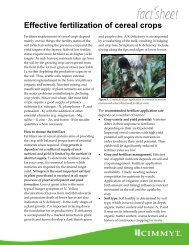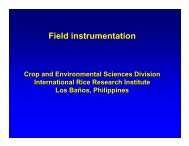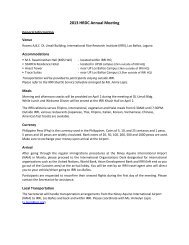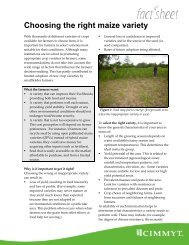Alternate Wetting Drying - Rice Knowledge Bank - International Rice ...
Alternate Wetting Drying - Rice Knowledge Bank - International Rice ...
Alternate Wetting Drying - Rice Knowledge Bank - International Rice ...
- No tags were found...
You also want an ePaper? Increase the reach of your titles
YUMPU automatically turns print PDFs into web optimized ePapers that Google loves.
Saving Water:<strong>Alternate</strong> <strong>Wetting</strong> <strong>Drying</strong> (AWD)Water ScarcityWorldwide, water for agriculture is getting increasingly scarce. By 2025, 15-20 millionhectares of irrigated rice may suffer water scarcity. Interventions to respond to water scarcityare called “water-savings” and imply a reduced use of irrigation water.rice fact sheetsWhat is AWD?<strong>Alternate</strong> <strong>Wetting</strong> and <strong>Drying</strong> (AWD) is a water-saving technology that lowland (paddy) ricefarmers can apply to reduce their water use in irrigated fields. In AWD, irrigation water isapplied to flood the field a certain number of days after the disappearance of ponded water.Hence, the field is alternately flooded and non-flooded. The number of days of non-floodedsoil in AWD between irrigations can vary from 1 day to more than 10 days.How to implement AWD?A practical way to implement AWD is to monitor the depth of ponded water on the field usinga ‘field water tube’. After irrigation, the depth of ponded water will gradually decrease. Whenthe ponded water has dropped to 15 cm below the surface of the soil, irrigation should beapplied to re-flood the field with 5 cm of ponded water. From one week before to one weekafter flowering, ponded water should always be kept at 5 cm depth. After flowering, duringgrain filling and ripening, the water level can drop again to 15 cm below the surface before reirrigation.AWD can be started a few days after transplanting (or with a 10-cm tall crop in directseeding). When many weeds are present, AWD can be postponed for 2-3 weeks until weedshave been suppressed by the ponded water. Local fertilizer recommendations as for floodedrice can be used. Apply fertilizer N preferably on the dry soil just before irrigation.Safe AWD?The threshold of 15 cm water depth (below the surface) before irrigation is called ‘Safe AWD”as this will not cause any yield decline. In Safe AWD, water savings are in the order of 15-30%. After creating confidence that Safe AWD does not reduce yield, farmers mayexperiment by lowering the threshold level for irrigation to 20, 25, 30 cm depth, or evendeeper. Lowering the threshold level for irrigation will increase the water savings, but someyield penalty may occur. Such a yield penalty may be acceptable when the price of water ishigh or when water is very scarce.Find Out More about <strong>Alternate</strong> <strong>Wetting</strong> and <strong>Drying</strong>:Send an email to: r.lampayan@cgiar.org.Visit http://www.knowledgebank.irri.orgDownload the book “Water management in irrigated rice - Coping with water scarcity”at: http://books.irri.org/9789712202193_content.pdfor at: http://www.irri.org/publications/techbulletin/tech.asp?id=10Developed with input from: B.A.M. Bouman and R. M. LampayanProduced by the <strong>International</strong> <strong>Rice</strong> Research Institute (IRRI) • © 2009, IRRI, All rights reserved • August 2009
<strong>Alternate</strong> <strong>Wetting</strong> <strong>Drying</strong> – Page 2 of 2rice fact sheetsThe Field Water TubeA tube can be made of 40-cm long plastic pipe or bamboo,and have a diameter of 15 cm or more so that the water tableis easily visible. Perforate the tube with holes on all sides. Digthe tube in the soil so that 20 cm protrudes above the soilsurface. Take care not to penetrate through the bottom of theplow pan. Remove the soil from the inside so that the bottomof the tube is visible. Check that the water table inside thetube is the same as outside the tube. The tube can be placedin a flat part of the field close to a bund, so it is easy tomonitor the ponded water depth.A Field tube underFlooded conditionsField water tube from PVCNote the holes on all sidesWater at 15 cm depth:Time to irrigate and floodthe field againFind Out More about <strong>Alternate</strong> <strong>Wetting</strong> and <strong>Drying</strong>:Send an email to: r.lampayan@cgiar.org.Visit http://www.knowledgebank.irri.orgDownload the book “Water management in irrigated rice - Coping with water scarcity”at: http://books.irri.org/9789712202193_content.pdfor at: http://www.irri.org/publications/techbulletin/tech.asp?id=10Developed with input from: B.A.M. Bouman and R. M. LampayanProduced by the <strong>International</strong> <strong>Rice</strong> Research Institute (IRRI) • © 2009, IRRI, All rights reserved • August 20092


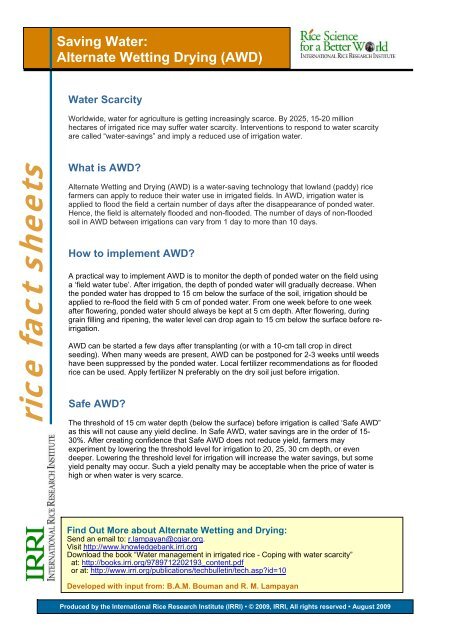


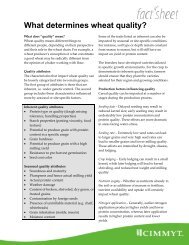

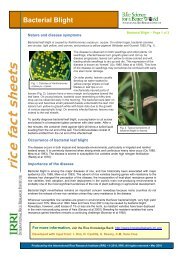

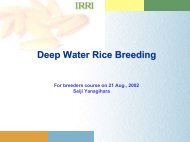
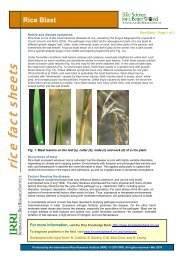
![International Standards' Organization â Rice Specification [ISO 7301]](https://img.yumpu.com/36696862/1/190x245/international-standards-organization-a-rice-specification-iso-7301.jpg?quality=85)

